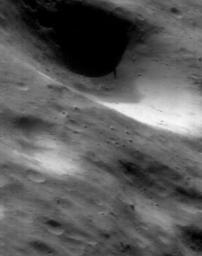
|
The Impact of Cratering
- Click the image above for a larger view
- Full-Res JPEG (372 x 472) (17.8 kB)
- Full-Res TIFF (372 x 472) (115.8 kB)
Caption:
Impacts to Eros slowly and continually modify the appearance of the asteroid's surface. This NEAR Shoemaker image taken July 23, 2000, from an orbital altitude of 38 kilometers (24 miles), shows the effects around a crater that is nearly a mile (1.6 kilometers) across. An impact excavated a huge gouge, and caused some of the excavated material to form a thin cover on parts of Eros. The fastest-moving fraction of the crater's ejecta (traveling at more than several meters per second) escaped Eros, whereas slower-moving material eventually returned to the surface. The boulders in the foreground, about 15 meters (50 feet) across, are typical of the largest pieces in a crater's ejecta. Over time the surface layer slid off the crater's walls to expose brighter material from below, which has not yet been darkened by space weathering. The picture shows a region about 1 kilometer (0.6 miles) across.
Background Info:
Built and managed by The Johns Hopkins University Applied Physics Laboratory, Laurel, Maryland, NEAR was the first spacecraft launched in NASA's Discovery Program of low-cost, small-scale planetary missions. See the NEAR web page at http://near.jhuapl.edu/ for more details.
Cataloging Keywords:
| Name | Value | Additional Values |
|---|---|---|
| Target | 433 Eros | |
| System | Near Earth Objects | |
| Target Type | Asteroid | |
| Mission | NEAR Shoemaker | |
| Instrument Host | NEAR Shoemaker | |
| Host Type | Orbiter | |
| Instrument | Multi-Spectral Imager (MSI) | |
| Detector | ||
| Extra Keywords | Crater, Grayscale, Impact | |
| Acquisition Date | ||
| Release Date | 2000-08-05 | |
| Date in Caption | 2000-07-23 | |
| Image Credit | NASA/JPL/JHUAPL | |
| Source | photojournal.jpl.nasa.gov/catalog/PIA02958 | |
| Identifier | PIA02958 | |
